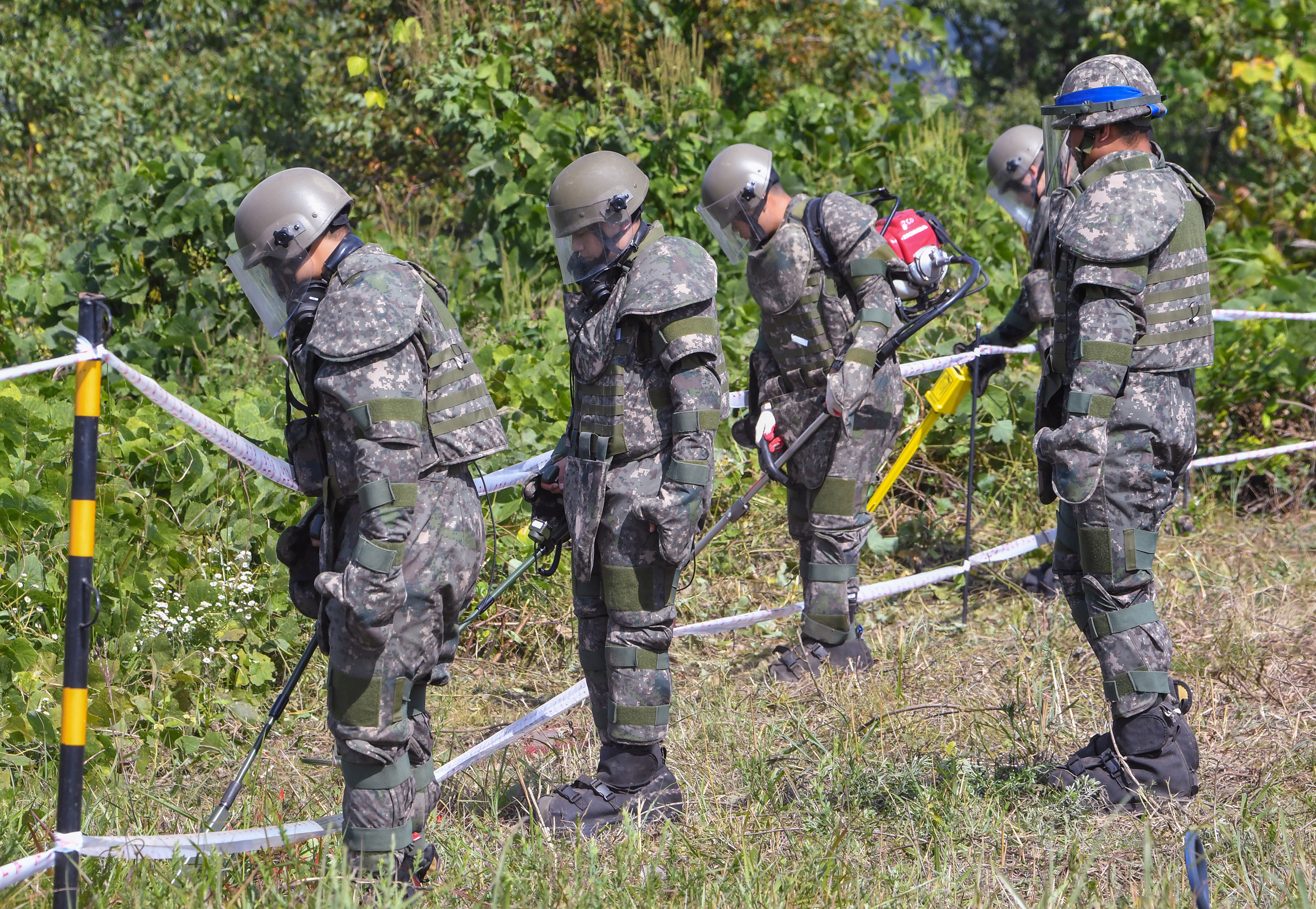
In this photo taken on October 2, 2018, South Korean soldiers conduct landmine clearing operations inside of the Demilitarized Zone (DMZ) dividing the two Koreas in Cheorwon, south of the DMZ. The two Koreas on October 1 started to remove landmines along a section of their heavily fortified border as part of a summit deal to ease military tensions, Seoul said. AFP
CHEORWON, South Korea – There has been no breakthrough in the removal operation since it began Monday. Neither landmines nor war remains had been found at the mountainous region as of Tuesday midday. Only a few unexploded bombs had been recovered, according to the military.
A group of soldiers who gathered at the entrance of the heavily fortified Demilitarized Zone in Cherwon began picking up gear for a special mission Tuesday: a grass cutter, metal detector and air pressurizer.
It is Day 2 of the mission to locate landmines buried at Arrow Head Hill in Cheorwon County, Gangwon Province, one of the two major sites where the two Koreas began demining operations to clear the path for excavation of the remains of those killed during the 1950-53 Korean War.
The soldiers’ journey involves traveling through no man’s land at the heart of the Korean Peninsula. Inside the 250-kilometer-long, 4-kilometer-wide DMZ, about 2 million mines are thought to be buried across.
“Safety is of our utmost concern. We will never put our soldiers in harm’s way,” an Army general overseeing the mine removal operation tells a group of reporters at a guard post inside the DMZ. Citing official rules, the general requested anonymity.
“While there is no written record about the massive planting of landmines, we have to be extremely careful. We might come across unexploded bombs or anything else that could harm our service members,” he says.
Toward the end of the Korean War in 1953, a fierce battle was fought here between the militaries of North Korea and China on the one side and the allied forces of South Korea, US and United Nations on the other. The battle over control of the stronghold resulted in thousands of casualties.
Hence the choice of the particular area for the landmine removal operations at last month’s inter-Korean summit in Pyongyang. The other site to be demined is near the Joint Security Area inside the border village of Panmunjom.
While North Korea has yet to provide information about the location and schedule of its own demining operations, the South Korean commander says North Korea might have launched similar steps, though it is hard to see from the southern side.
“We suspect that North Korea’s landmines are mostly buried behind the mountainous area, so what we can observe is limited. But we’re pretty sure they did the same thing in their own area,” the commander says.
Teamwork is the most important thing in removing mines. When mines are found by those at the front of a search team, those following behind remove obstacles until explosive ordinary disposal specialists are able to take the mines out of the DMZ for removal.
Due to the excruciating nature of the demining process, the 12-member crew can only work a total of four hours per day — two hours in the morning and two hours in the afternoon. Rotation takes place every 10 to 15 minutes.
Such restrictions limit the size of the search area that can be covered daily. When winter arrives, the situation will worsen, which is why the demining operations can last through the end of November.
“If snow falls, the search area ground will freeze. It’s an extremely harsh condition for detecting mines and removing them. We are seeking to speed up the process before winter arrives,” the commander says.
South Korea’s military suspects that unlike other landmine zones inside the DMZ, the number of landmines at Arrow Head Hill may be small. Mines are usually buried on flat ground with little fighting, not rocky hilltops where fierce battles occur.
The obvious challenge for the demining crew is that it does not know exactly where the mines have been planted. The military believes that if Arrow Head Hill was not a meticulously designed mine burial site, fighting forces could have planted them at random.
The demining experts’ best guess is that the mines could have been buried along the trenches surrounding Arrow Head Hill, a major transportation route for combat forces under the hail of gunfire during the war.
“We are going to conduct search operations along the trench. From there, we are going to expand the search area incrementally. It is like using previous pathways before venturing into a new area,” the commander says.
The demining operation is conducted under the watchful eyes of personnel from the United Nations Command, which controls the DMZ. Two UNC personnel stand at the entrance of the restricted zone and monitor convoys carrying mine-removal equipment.
There has been no breakthrough in the removal operation since it began Monday. Neither landmines nor war remains had been found at the mountainous region as of Tuesday midday. Only a few unexploded bombs had been recovered, according to the military.
However, the demining crews hope to discover more mines and remains before the arrival of winter. When a cross-border road is completed in November, they will have better access to the search site.
“The main purpose of the demining operations is to create a path before the two Koreas launch a joint excavation project for the war remains. … The better access we have to the area, the more likely we will find mines or remain,” the commander says.